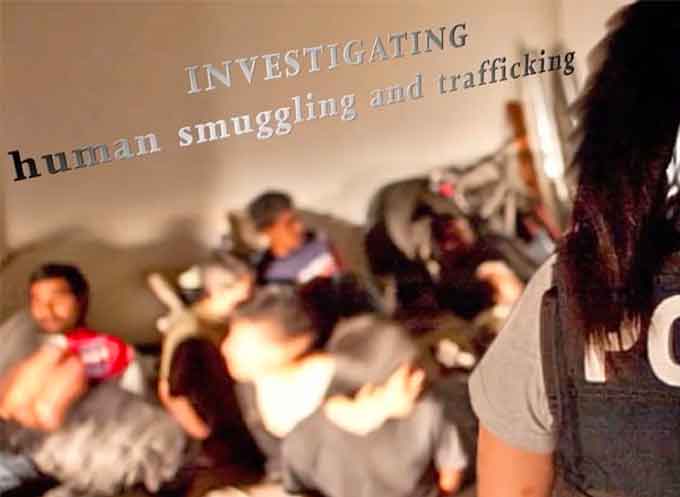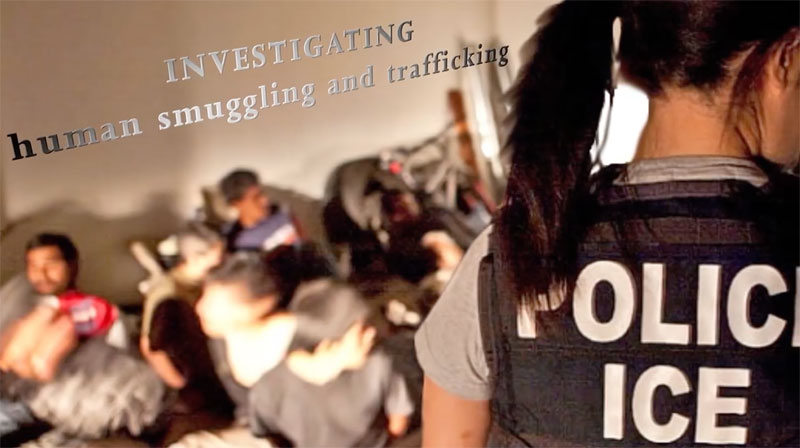
Following an investigation by U.S. Immigration and Customs Enforcement’s (ICE) Homeland Security Investigations (HSI) in New York, four individuals have been extradited from Mexico to the United States to face sex trafficking charges.
- Efrain Granados-Corona, aka Chavito, aka Cepillo
- Emilio Rojas-Romero, Alan Romero-Granados, aka El Flaco, and
- Pedro Rojas-Romero
- are charged together with
- Raul Romero-Granados, aka Chicarcas, aka El Negro
- Isaac Lomeli-Rivera, aka Giro
- Julio Sainz-Flores, aka Rogelio, and
- Juan Romero-Granados, aka Chegoya, aka El Guero
- with sex trafficking offenses in a 23-count Superseding Indictment in the United States District Court for the Southern District of New York.
Efrain Granados-Corona and Emilio Rojas-Romero were extradited to the United States from Mexico on April 26. Alan Romero-Granados and Pedro Rojas-Romero were extradited to the United States from Mexico Tuesday.
Efrain Granados-Corona and Emilio Rojas-Romero were extradited to the United States from Mexico on April 26.
Alan Romero-Granados and Pedro Rojas-Romero were extradited to the United States from Mexico Tuesday.
The indictment, which was returned under seal on Sept. 15, 2016 alleges that the defendants are members of an international sex trafficking organization that exploited and trafficked adult and minor women in Mexico and in the United States from at least 2000 to 2016.
Members of the defendants’ sex trafficking organization, which operated largely as a family business, used false promises, physical and sexual violence, and threats to force and coerce adult and minor women to engage in commercial sex for the organization’s profit in both Mexico and the United States.
As part of a coordinated bilateral law enforcement action, six defendants located in Mexico – Efrain Granados-Corona, Emilio Rojas-Romero, Alan Romero-Granados, Pedro Rojas-Romero, Julio Sainz-Flores, and Juan Romero-Granados – were arrested in Mexico and taken into custody by Mexican authorities pursuant to provisional arrest warrants submitted by the United States to Mexico in August 2016.
As noted, the first four of these defendants were extradited to the United States from Mexico within the past week.
The fifth of these defendants, Julio Sainz-Flores, was previously extradited to the United States from Mexico on June 8, 2017, and was presented in Manhattan federal court before Chief United States Magistrate Judge Gabriel W. Gorenstein on June 9, 2017.
Juan Romero-Granados remains in Mexico pending extradition proceedings.
The two defendants who were arrested in the United States, Raul Romero-Granados and Isaac Lomeli-Rivera, were presented in Manhattan federal court on Oct. 27, 2016.

“These four individuals were transported more than two thousand miles from Mexico to be held accountable for the callous criminal actions alleged in this case,” said Angel M. Melendez, special agent in charge for HSI New York.
“Those extradited, along with others, operated a family business centered on making money from exploiting females they forced into sex slavery.”
“Now these traffickers will face justice where they made their income, right here in New York.”
“Human Trafficking remains a priority for HSI whose primary focus is to rescue victims and release them from the grip of their captors.”
(Learn More. Human trafficking and human smuggling represent significant risks to homeland security. Would-be terrorists and criminals can often access the same routes and utilize the same methods being used by human smugglers. U.S. Immigration and Customs Enforcements Human Smuggling and Trafficking Unit works to identify criminals and organizations involved in these illicit activities. Courtesy of ICE .gov and YouTube)
“Sex trafficking is a heinous crime that violates oth the rule of law and the most basic standards of human dignity,” added US Attorney for the Southern District of New York, Geoffrey S. Berman.
“These defendants allegedly deprived women and girls of their freedom, and forced them into prostitution against their will.”
“The scope of devastation these defendants allegedy inflicted on countless victims is beyond comprehension.”

“But now they face significant criminal charges in an American court, and will have to answer for their allegedly reprensible actions.”
“Our office is dedicated to combatting this demoralizing crime and helping survivors reclaim their lives.”
As alleged in the indictment, Efrain Granados-Corona, Raul Romero-Granados, Isaac Lomeli-Rivera, Julio Sainz-Flores, Juan Romero-Granados, Alan Romero-Granados, Pedro Rojas-Romero, and Emilio Rojas-Romero, the defendants, are members of an international sex trafficking organization (the STO).
Many of the members of the STO are related by blood, marriage, and community.
For example: Efrain Granados-Corona is the uncle of Raul Romero-Granados, Isaac Lomeli-Rivera, Juan Romero-Granados, and Alan Romero-Granados; Pedro Rojas-Romero and Emilio Rojas-ROMERO are brothers; Juan Romero-Granados and Alan Romero-Granados are also brothers; and Isaac Lomeli-Rivera is Raul Romero-Granados’s brother-in-law.
Between 2000 and the present, members of the STO (the Traffickers) have used false promises, physical and sexual violence, threats of the same, lies, and coercion to force and coerce adult and minor women (the Victims) to work in prostitution in both Mexico and the United States.
(Ali, a young woman who fell into a life of drug addiction and prostitution in Philadelphia, describes the hold sex traffickers have on their victims and how she was ultimately able to escape the life with the help of a deputy sheriff on an FBI task force. Courtesy of the FBI and YouTube)
In most cases, a trafficker entices a victim – frequently a minor – in Mexico. The trafficker then uses multiple means to isolate the victim from her family.
In some cases, the trafficker uses romantic promises to induce the victim to leave her family and live with him. In other cases, the trafficker rapes the victim, making it difficult for her to return to her family due to the associated stigma of the rape.
Once a victim is separated from her family, the Trafficker frequently monitors her communications, keeps her locked in an apartment, leaves her without food, and engages in physical or sexual violence against the Victim.
Traffickers often tell victims that the Traffickers owe a significant debt and that the victim must work in prostitution to assist in repaying the debt.
Traffickers typically begin forcing the victims to work in prostitution in Mexico, frequently in a neighborhood of Mexico City known as La Merced.
Victims are often required to see at least 20 to 40 customers per day.
Traffickers monitor the number of clients a victim sees by surveilling the victim, communicating with brothel workers, and by counting the number of condoms provided to a victim.
Traffickers typically require the victims to turn over all of the prostitution proceeds to the traffickers.
After a victim has worked in prostitution in Mexico for some time, traffickers typically arrange for the victim to be smuggled into the United States.
Members of the STO assist one another in making smuggling arrangements. In many cases, multiple traffickers and multiple victims are smuggled into the United States together.
In other cases, one trafficker may remain in Mexico while arranging for a victim to be smuggled together with another trafficker and other victims.
Once in the United States, the members of the STO generally maintain their victims at one of several shared apartments in New York City. Victims living in the same apartment are frequently forbidden to communicate with one another.
Once in the United States, traffickers continue to use physical and sexual violence, threats of the same, lies, and coercion to force the victims to work in prostitution.
In most cases, the trafficker or another member of the STO provides a Victim with contact information with which to find work. The Victims typically work weeklong shifts either in a brothel, or in a delivery service.
In a delivery service, the Victim is delivered to a customer’s home by a driver.
These brothels and delivery services are located both within New York and in surrounding states, including, but not limited to, Connecticut, Maryland, Virginia, New Jersey, and Delaware.
Generally, each customer pays $30-35 for 15 minutes of sex. Of that, half of the money typically goes to the driver (in the case of a delivery service) or to the brothel.
The other $15 goes to the Victim, who is then typically forced to give all of the proceeds to the trafficker. When a trafficker is unavailable, a Victim may also give the proceeds to another member of the STO.
The traffickers then frequently send, or have their victims send, some of the prostitution proceeds to traffickers’ family members and associates in Mexico by wire transfer.
Such transfers provide financial assistance to the traffickers’ families and provide financial support to the traffickers themselves if they return to Mexico.
(Learn More, courtesy of the U.S. Department of Homeland Security and YouTube)
The charges contained in the indictment are merely accusations and the defendants are presumed innocent unless and until proven guilty.
The prosecution is being handled by the Violent and Organized Crime Unit of the U.S. Attorney’s Office for the Southern District of New York.
The HSI New York’s Trafficking in Persons Unit (TIPU) is comprised of senior criminal investigators, intelligence officers and victim assistance specialists who aid in the rescue of trafficking victims and prosecution of traffickers and trafficking organizations.
TIPU investigators focus on the exploitation of victims by force, fraud or coercion regardless of the person’s manor or entry into the United States.
All TIPU investigations are victim-centered, seeking to rescue and protect the victims of trafficking.

Indicators of Human Trafficking
Recognizing key indicators of human trafficking is the first step in identifying victims and can help save a life.
Here are some common indicators to help recognize human trafficking:
- Does the person appear disconnected from family, friends, community organizations, or houses of worship?
- Has a child stopped attending school?
- Has the person had a sudden or dramatic change in behavior?
- Is a juvenile engaged in commercial sex acts?
- Is the person disoriented or confused, or showing signs of mental or physical abuse?
- Does the person have bruises in various stages of healing?
- Is the person fearful, timid, or submissive?
- Does the person show signs of having been denied food, water, sleep, or medical care?
- Is the person often in the company of someone to whom he or she defers? Or someone who seems to be in control of the situation, e.g., where they go or who they talk to?
- Does the person appear to be coached on what to say?
- Is the person living in unsuitable conditions?
- Does the person lack personal possessions and appear not to have a stable living situation?
- Does the person have freedom of movement? Can the person freely leave where they live? Are there unreasonable security measures?
Not all indicators listed above are present in every human trafficking situation, and the presence or absence of any of the indicators is not necessarily proof of human trafficking.
(The Blue Campaign is the unified voice for the U.S. Department of Homeland Security’s (DHS) efforts to combat human trafficking. Working in collaboration with law enforcement, government, non-governmental and private organizations, the Blue Campaign strives to protect the basic right of freedom and to bring those who exploit human lives to justice. Courtesy of DHS and YouTube.)
Partnerships
The Department of Homeland Security cannot combat human trafficking alone.
The President’s Interagency Task Force to Monitor and Combat Trafficking in Persons (PITF) brings together federal departments and agencies to ensure a whole-of-government approach that addresses all aspects of human trafficking.
The fight requires the contributions of all, including:
- Workers on the front lines – first responders, social workers, community volunteers, healthcare providers, teachers, and law enforcement;
- A range of organizations – private, public, and non-profit – who are committed to social responsibility and willing to speak out about this terrible scourge;
- Faith-based networks and houses of worship;
- Government entities that create and foster strong relationships to bring communities together and facilitate collaboration and the sharing of best practices; and
- Members of the public who, through the knowledge of their communities, can be the greatest asset in this fight.






















